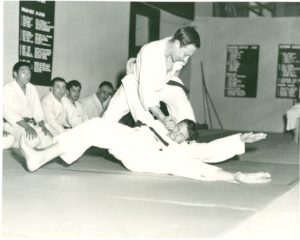Here is an interview with Prof. Jerry Kunzman – 9th Dan in Zenbudo-Ryu Jujitsu concerning how he started in Jujitsu.
1. What year did you begin training in Jujitsu?
It must have been in 1960 because I started a new job in 1959 and remember discussing it with my new co-workers a few months after I joined them. They thought I was crazy to get involved with “things like that”. In those years, the martial arts (Judo, Ju Jitsu, and Karate) were still “mystical” and usually Caucasians were not welcome in most dojos. And few Caucasians knew anything factual about “things like that”.
2. How did you first become aware of Jujitsu?
Serendipitously.
As I recall now, the word “Judo” was familiar because of the infamous “Judo Chop”, as it was called then in, movies and other media. I only had a vague concept of the others. I think I found a book at the library on Ju Jitsu, illustrated with pictures of Japanese men in suits and derby hats doing their “tricks”. That looked like fun and an effective form of self-defense.
At the time (1960), there was a lot of publicity in the media about the Hells Angels motorcycle gangs raising hell. Being a “smallish” person (5’-9” and 135 pounds), I realized that I would be easy fodder for them if I was so unfortunate to be in their area at the wrong time and I needed to do something about learning to defend myself better.
With those two things in the back of my mind, several months passed and I was driving down Taraval St. in San Francisco when I spied a sign outside a store front. The sign advertised “Judo, Ju JItsu, and Karate ”, a rare find in those days. I stopped and went inside to see what that was about, given my recent thoughts (above). It was a typical dojo as we commonly see these days. The instructor on the mat was Rich Leviton, a 16 year old black belt in both Ju Jitsu and Karate, who greeted me with a smile and was very courteous and respectful (after all, I was his senior at 23 J). He carefully and patiently explained the program to me and I think I signed up on the spot.
I eventually learned that this dojo was one of the 5 dojo’s that Hanshi Duke Moore had in t he San Francisco Bay Area and one of the few that were open to the general public. So by dumb luck, I stumbled into what is probably one of the finest, most versatile martial arts systems available anywhere in the area at the time!
3. What was your first week like at your Jujitsu Dojo?
I don’t remember the details but I do recall that I spent a lot of time “slapping the mat”. I just did as I was told. I could see where the training was headed by observing the other, more advanced students and I just trusted that the system would take me there.
4. What interested you most about Jujitsu? Was there an experience, person, or concept that really fascinated you and kept you coming back?
The power of the art was amazing to me. The ability to control and “defeat” much larger opponents with such ease fascinated me. Sensei Leviton was a good and kind instructor and (predictably) the other students mirrored his persona, so I made friends easily.
5. What were your first impressions of your instructor?
I was impressed with a 16 year old conducting classes in Ju Jitsu and Karate by himself. I instinctively felt that this was something unusual and I wanted to be a part of it.
6. As a new student, what were your biggest challenges?
There were two: Getting my white belt tied correctly and trying to not break anything! J
During my 50 years in the arts, I have sprained almost every joint in my body (some several times), survived multiple bruises and injuries but never missed a class. So I guess I met my two biggest challenges; I now can tie my belt correctly and I never broke anything (except for a cracked rib on two different occasions but that doesn’t count! J ).
7. If there is anything you could tell a new student to help him in his Jujitsu journey, what would that be?
I think the most important thing that a new student needs to understand and buy into is this: Do not look ahead; do not be ambitious; do not be concerned about the color of your belt! Take each step one at a time. The belt is there to hold your gi closed. The color of your belt is for the benefit of your instructor, not for your benefit.
As you advance, you will be assigned to teach those at lower ranks. While that may seem boring (after all, you already “know” that stuff and you want to learn new stuff), you learn even more by teaching (under the supervision of your Sensei of course). You are also being prepared to some day run your own classes.
Finally, NEVER miss a class. If you have to be brought in by wheelchair or stretcher, you will still learn by observing! Professor Jerry Kunzman – 9th Dan – Zenbudo-Ryu Jujitsu
Stay tuned for the continued story…….



This is really great. What a person to be able to interview! Love the part about coming to class in a wheelchair if necessary LOL. That might be you tough mudders after this weekend!